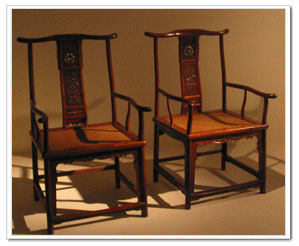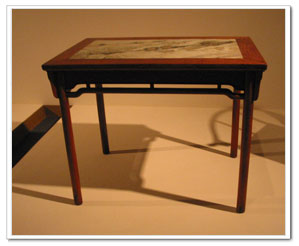Chinese Ming furniture is known for its simple and elegant design with fluent lines and appealing proportions. Qing furniture is larger than that of the Ming Dynasty and more imposing, with elaborate carving and inlaid decoration. Both types are prized for their fine materials, special workmanship and high artistic level.
Major types of Chinese Ming and Qing furniture
Type | Name | Characters |
| Stool | Square stool | A square seat with no back and arms, one of the basic form of' the type. |
| Folding stool | A cross-legged stool, consisting of eight straight pieces of wood. It is widely used and easy to carry. | |
| Chair | Official' hat armchair | The name comes from its top rail, which looks like a Ming official hat. The one with the ends of its top rail and arms protruding is called "Official hat armchair with four protruding ends"; the one without that called "Southern official's hat armchair" |
| Armchair with curved rest | The westerns call it horseshoe armchair. (excluding the folding chair with curved rest) | |
| Folding chair with curved back | A folding stool added with a back. There were two kinds in tile Song dynasty: one with a straight back and the other with a curved back. The latter was popular in the Ming dynasty. | |
| Table | Square table | There are two types of Chinese table. One called "Zhuo" has its four legs supporting at the four corners; the other called "An" has its legs recessed from corners. A large square table is usually sit by eight people called in Chinese "Baxianzhuo", Eight Immortals table. |
| Narrow rectangular table | It could be used as a lute table, painting table or writing table. | |
| Half table | It could be used as a lute table, painting table or writing table. | |
| Kang table | A short table used on Kangs, it kind of chair-level bed that is usually built-up with bricks and can be heated underneath and also used for daytime sitting in north | |
| Narrow rectangular table with recessed legs | It is narrow and long and of a high level. The one with a flat top called "Pingtiao'an" in Chinese; the one with everted flanges at the two ends of the top called " Qiaotou'an". | |
| Narrow rectangular trestle table | The framed floating panel is supported by two rectangular stands, easy to move. | |
| Bed | Canopy bed | There were four- or six-post canopy beds in ancient China. |
| Luohan bed | Beds have back and side railings. | |
| Screen | Folding screen | It is made from many panels that can be arranged in different configurations. |
| Serene set in a stand | It has its central screen panel set in a stand. | |
| Screen set in a stand with a removable panel | It has its central screen penal inserted into the grooves at the inner sides of the frame posts. So the panel is removable. | |
| Ink-stone screen | A kind of small screen placed on the narrow rectangular table for decoration or to protect the candle light from wind |
Terms for structure parts of Chinese Ming and Qing furniture
Armchair
1. Top rail
2. Spandrel, at the corner of a joint.
3. Side post.
4. Gooseneck post, the front supporting post of an arm.
5. Arch-shaped apron.

Table
1. Ice-plate edge, a downward-contracting edge of a frame member.
2. Decorative strut.
3. Humpbacked stretcher.
4. One leg with two aprons and one spandrel.

Source:
http://www.china-tour.cn/Chinese-Arts/Chinese-Ming-Qing-Furniture.htm





